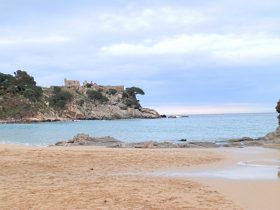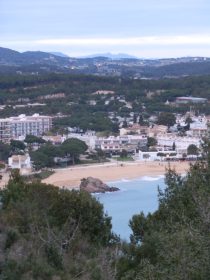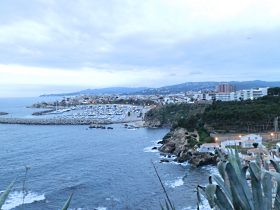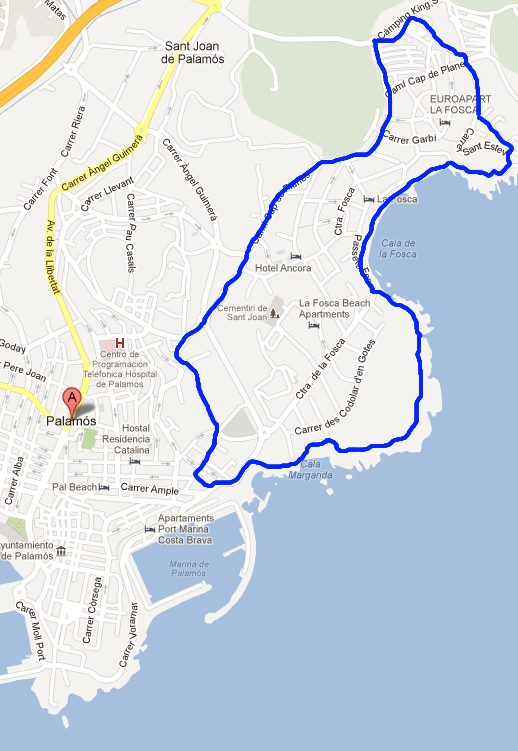La Fosca to Palamos
 La Fosca is Palamos's 'hidden' beach, on the other side of the town to the main Palamos bay that runs down past St Antoni de Calonge. And in total contrast to the main beach, La Fosca is a gem of a beach formed by two crescents of sand under the ruins of the castle of Sant Esteve.
La Fosca is Palamos's 'hidden' beach, on the other side of the town to the main Palamos bay that runs down past St Antoni de Calonge. And in total contrast to the main beach, La Fosca is a gem of a beach formed by two crescents of sand under the ruins of the castle of Sant Esteve.
La Fosca is the beach with the softest sand and, because the water is shallow for a long way out, it's both great for children and as the best beach for an early summer swim at the end of May or start of June, as the shallowness helps the water temperature.
In fact La Fosca is so close to Palamos that it'll seem a little odd to describe a walk between the two. Most people will know the road route. In fact the footpath runs over a small headland that is sufficiently high to give excellent views along the coast to Castell and across the countryside up towards Palafrugell, so it is good as a shorter evening walk as the nights become longer.
 To start we parked just outside King's Campsite - a campsite popular with British visitors and children on PGA adventure holidays. Walking around the back of the campsite, we reach the sea just ahead of the Castle of St Esteve.
To start we parked just outside King's Campsite - a campsite popular with British visitors and children on PGA adventure holidays. Walking around the back of the campsite, we reach the sea just ahead of the Castle of St Esteve.
The castle was an important outpost in the fortification of the area and though ruined now, it's scheduled to be renovated at least to the point that visitors can have access.
From the castle, we follow the steps down to the beach and then walk across the beach. Beach volleyball players were just packing up. As the beach has the best sand and is relatively broad with good access, it's the perfect local beach for volleyball players.
At the back of the beach are a number of older Indiana-type houses (built by returning Catalans who had made their fortunes in tobacco or sugar out in Cuba), but the area has been tastefully developed and feels like a graceful place for holidays.
From the second half of the beach we have to take the walk a little way, before following the red-white flash of the GR92 past the boat houses and then round the edge of a house and up onto the headland.
The path climbs quickly above a crag in the rocks, with views back to La Fosca and the castle across the bay. At the top of the headland is a vantage point where you can look up the coast to the Formiga islands and the bays along past Platja Castell.
 On the other side of the headland, the marina at Palamos is in front of us, with the first evening lights coming on and the town church standing on top of the end hill of the town.
On the other side of the headland, the marina at Palamos is in front of us, with the first evening lights coming on and the town church standing on top of the end hill of the town.
Walking off the headland, is a final treat - a small hidden bay tucked off the path. Then we're on the road towards Palamos.
Instead of going all the way into Palamos, we cut through the houses. These are small streets of terraced houses of working people, far from the holiday villas you find elsewhere.
Palamos was once a royal port and garrison and has a harbour large enough for cruise liners. It's also renowned for its fishing - in particular Palamos Prawns, a speciality of the area which are feted by chefs across the world (with prices to match).
The tangle of streets emerges at a roundabout opposite one of the other campsites in the area. We walk along the lane with the evening closing in and return to the car.
Update 2021: The path from up around the headland as you leave La Fosca has been updated, and the path greatly improved at the back of the port, with a wooden walkway off the cliffs to avoid the road making the path much more attractive and giving a much better connection to Palamos without the diversion through town.
Neighbouring walks: Platja de Castell and La Fosca - Calella de Palafrugell/Cap Roig to Castell - classic wild Costa Brava - Mont-ras to Calella de Palafrugell and Llafranc - Bell-lloc and Castell de Vila-Roma (Palamos) - Eulogy to the Ruta del Tren Petit (Palafrugell, Palamos, Mont-ras and Vall-llobrega) - St Antoni de Calonge, Torre Valentina to Platja d'Aro (almost)
Swimming: Swimming and beach at La Fosca


 Walks and other things
Walks and other things